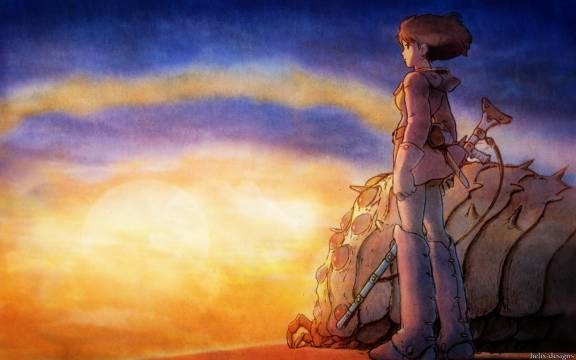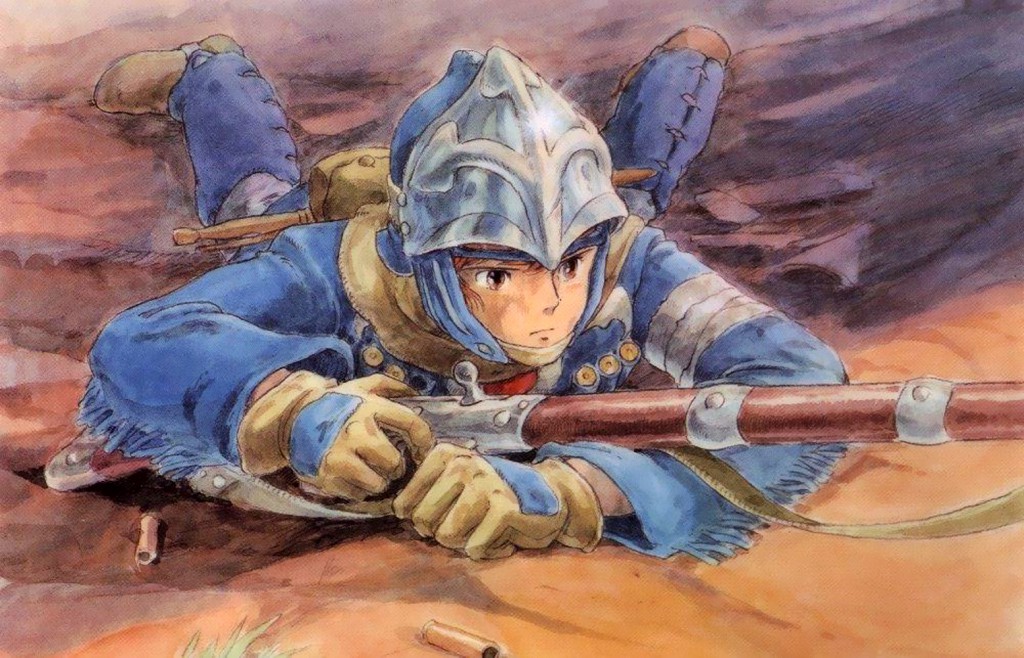
Written and directed by Hayao Miyazaki
Japan, 1984
An escapist, morally simplistic tale purveying hackneyed truisms masquerading as profundities, Nausicaä of the Valley of the Wind is animation legend Hayao Miyazaki’s second feature and his inexperience as a writer shows. His debut is the relatively obscure Lupin III: The Castle of Cagliostro, which this column will cover at some point in the future. This film’s financial success led directly to the creation of Studio Ghibli, and for that, it is of monumental importance. Its influence on anime as a whole looms large as well, for better and worse. As much as it may be painful for the inaugural edition of this column to be a negative review, it’s important to note that not all animation from abroad is of high quality by default. So let’s talk about this mess.
The best part of the film is the visuals. This may be the most beautiful film in the Ghibli canon, among which it is customarily included. The world is truly distinct and every frame breathes uniqueness. It’s exactly what you hope to achieve with an animated fantasy epic. Miyazaki directs every frame with astonishing beauty and a passion that draws you in with no aid from its subpar excuse for a story; his directorial chops are evident even this early. This makes it an enchanting, though periodically restless, sit on at least a visual level that almost feels emotionally satisfying after two hours. But to ignore the severe lack of substance underneath is a fool’s mistake.

Being whisked away through the power of cinema to these gorgeous environments has its shallow pleasures. But many sections spent in the actual valley of the wind are distinctly lacking. It looks too quaint and its hominess is an unwelcome distraction from the rest of the film’s playgrounds of adventure. Not helping is the fact that this is where so much of the film’s “story” takes place. Thus, the film is plagued with frequent segments of visual blandness, weakening even its strongest asset.
Nausicaä as a character is intensely boring. She exists only to say things that are “good” in the mind of the director and since she’s the protagonist, she always has to be right. No one else understands how wonderful nature is and how bad killing and war are! Identify with this protagonist and feel righteous in your mutual endorsement of the obvious, moviegoer! Feel fulfilled and special when you’re the only one who can stop some atrocity with your superior generic views! But that’s not all. She also gets to strike generic film poses with her admittedly pleasant character design. Classic examples include the dramatic turn whilst saying only “It’s just…”, pausing to decide whether or not she can really confide in the person she’s speaking to; the lean against an object to look insouciant and cool; and, of course, the ever-ubiquitous Jesus Christ pose.

The Christ analogy is not only entirely obvious, but is a naked ploy to add an illusion of character depth. It’s really nothing more than yet another self-insert “chosen one” story. Unfortunately, the fact that the lead is female isn’t enough to excuse this decision. Idealizing female characters as mystical beings who are more goddess than human isn’t empowerment; it’s an attitude that stems from the same lack of understanding present in media that seeks to marginalize women. Those who say this kind of characterization is equally as damaging to feminism may be exaggerating, but the characterization isn’t doing feminism the favor it thinks it is. Japanese cinema had been doing this for decades prior, so it’s even less impressive.
Lord Yupa similarly is nothing but another cool badass whose true nature remains a mystery throughout the entire film, though it’s more vague than ambiguous. He has no reason for doing anything other than his apparent goodness. The most memorable thing Lord Yupa does, besides being voiced by Patrick Stewart in the English dub, is to quell a violent outburst Nausicaä has at one point that might have been actual character conflict had Miyazaki followed through on its consequences. Instead of struggling to overcome her violent human nature, she immediately reverts to telling everyone else violence is bad and never once remembering that she hypocritically gave into such urges. Her fit of rage serves as something far more sinister: a chance for her to be cool in yet another way so we can give her an awesome sword fight. But don’t worry; this anger is over the death of her father, so it’s righteous. Justifiable as that may be, the fact that Nausicaä preaches against violent revenge, as well as what might be traditionally thought of as more senseless, undermines the film’s hopelessly didactic blather of a message. As if it wasn’t already trite, it somehow also manages to be confused.

To the film’s credit, it doesn’t glorify violence, even against the mustache-twirling villains, though it still doesn’t provide enough moral greyness. The leader of the Tolmekian army that occupies the valley, Princess Kushana, expresses her affinity for the evil of the destructive, frightening, and beautifully designed giant warrior at one point. She has also lost much of her physical body in battle, which could’ve made for a compelling and sympathetic villain, but she is also typically wasted. The other villain, Officer Kurotowa, is the badly needed comic relief of this lumbering, self-important slog, and he is easily the second best thing about the movie. He’s genuinely funny, but not overbearingly so and wants to usurp the role of his superior Kushana as leader of the army, though he does not act on this and is nothing more than another element added to make the film more watchable. There’s really nothing else to say about these two besides the obvious aside that their character designs look nice. There are flashes of depth in both that may have been expanded in the manga, but there’s ultimately nothing in the film except a couple of flat antagonists.
The plot is so lacking in coherency it’s enough to make one fall asleep and have a better adventure set in this world in dreams. Even ignoring the fact that there is nary a character-driven plot point in sight, Nausicaä doesn’t succeed as a shallow story through its swift dismissal of internal logic. Everything is driven by ill-defined notions of good and evil, which are ironically over-defined whenever Nausicaä spouts her simplistic claptrap about how killing is bad and nature is good. Like any bad children’s film, it relies on our preconceptions of good guys and bad guys rather than developing its own.

For example, the Pejite peoples’ nonsensical plan for revenge would not only wipe out solely a fraction of the evil Tolmekian army, but it requires the collateral damage of the inconsequential valley of the wind and their own city, which is presumably their entire sovereign state. Good revenge plan! Not to mention the fact that the rest of Tolmekia would be incredibly mad and come after Pejite’s few remaining warships with their larger army still in reserve. This plays like a failed attempt at moral complexity, where the victim becomes the attacker, which would still be terrible because violence and war is bad, because Nausicaä said so. In fact, the point where the moral question of whether or not to kill the Tolmekians would be raised is glossed over in favor of the next point, where the wonderful, innocent people of the valley of the wind would be wiped out along with them. In truth, every attempt the film has to explore any notion of real good and evil is quickly tucked away so uncle Miyazaki can tell you right from wrong.
In truth, almost every issue this film has feels like it can be traced back to a single directorial decision. It appears that every bit of intrigue or nuance present in Miyazaki’s original manga has been eschewed to make way for plot and ham-fisted moralizing. It’s a fatal truncation that serves to do nothing but handicap the surviving narrative to the point of utter boredom.


There are some brief moments in the film that almost make it feel salvageable, but those are quickly overshadowed by Miyazaki’s need to get his obvious message across. While modern anime aesthetic owes a huge debt to the film, its storytelling isn’t awful in a unique enough way to trace any current undercooked work back solely to this source. The film has at least influenced someone with its failure of a story, though. The man who directed Nausicaä of the Valley of the Wind returned to this environmentalist epic template and made a masterpiece 13 years later with a more seasoned, subtle style. Besides the added experience at filmmaking, Miyazaki’s personal politics had also shifted away from the simplicity of his earlier effort, allowing him to craft a more substantive and balanced film in Princess Mononoke.
If there is a reason to recommend this, it’s for pure escapist purposes. Turning off your brain may not be the best way to enjoy a film, but this is a total immersion into a wonderful, yet completely stupid world. Also, this is a film made with a true passion by a then-underdeveloped writer. While this passion is infectious, it isn’t enough to excuse the film’s many failings. This is a bad movie, but it spawned so many better ones it can be saluted for its service, if not praised for its own merits. Watchable in a strictly serviceable sense of the word, Nausicaä of the Valley of the Wind is like its view of the world: a beautiful landscape inhabited by a pack of senseless humans we would be better off without.
– Autumn


